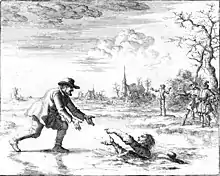Beachy Amish
The Beachy Amish Mennonites are formally a subgroup of Amish but they are much less traditional than other Amish. Even though they have retained the name "Amish" they are quite different from the common idea of Amish: they do not use horse and buggy for transportation, with a few exceptions they do not speak Pennsylvania German anymore, nor do they have restrictions on technology except for radio and television. In the years 1946 to 1977 a majority was transformed into an evangelical revivalist denomination.[1] The traditionalists who wanted to preserve the old Beachy Amish ways then withdrew and formed their own congregations. Today they are known as Midwest Beachy Amish Mennonites or Old Beachy Amish.[2]
| Part of a series on |
| Anabaptism |
|---|
 |
|
|
They form a loose association of churches without a central governing body; therefore, few common characteristics are shared by all Beachy congregations. Some similarities include adhering to the Dordrecht Confession of Faith and practicing varying degrees of Anabaptist practice, such as nonresistance, separation from the state, and adult baptism.
History
The Beachy church arose from a 1927 division in the (Casselman) River Old Order Amish congregation in Somerset County, Pennsylvania.[3] Bishop Moses M. Beachy led the congregation during that time and his name became associated with the faction. The Beachys favored a milder discipline for members whose only offense was transferring membership to other Anabaptist churches, specifically the conservative Amish Mennonite congregation that broke from Moses Beachy's congregation (then not under Beachy's leadership) in 1895.[4]
The Beachy Amish were transformed at mid-20th century into a more evangelical group by both the incorporation of revivalist Amish who had left their original churches and joined the Beachy Amish and by a growing revivalist influence within the Beachys.[1] One especially influential man in Lancaster County was an Amish (and later Beachy Amish) evangelist from Oklahoma, David A. Miller. Through his and other revivalist influences an Amish youth group evolved known as the "Goodies" due to their emphasis on a renewed spiritual life and avoiding the period of rumspringa as experienced in many Amish youth groups. Many of the "Goodies" eventually joined the Beachy Amish community in Lancaster County.[5]
Distinctives
In contrast to the Old Order Amish, the Beachys have meetinghouses, Sunday School, and a Bible School for young adults, and most also support missionary work. Excommunication is used less frequently and accompanying bans are even rarer.
Most Beachy churches today more closely resemble the Conservative Mennonites (which see for fuller discussion of beliefs/distinctive under that entry) rather than the Old Order Amish. The practices and lifestyle still similar to the Old Order Amish include:
- Women wear head covering
- Married men have beards in most congregations
- Television and radio are forbidden
Practices that distinguish the Beachy church from the Old Order Amish include:
- Filtered Internet is permitted by most congregations
- Men wear ready-made clothing
- Ownership of personal automobiles.
Population and distribution
In 2006, there were 11,487 Beachy members in 207 churches,[6] with the highest representation in Pennsylvania, Indiana and Ohio.[7] International Beachy churches or mission work can be found in El Salvador, Belize, Nicaragua, Costa Rica, Paraguay, Ireland,[8] Ukraine, Romania, Kenya, Australia, and Canada. Mission work is sponsored by Amish Mennonite Aid (AMA), Mennonite Interests Committee (MIC), or individual churches.
See also
- Weavertown Amish Mennonite Church – Oldest existing Beachy church
Literature
- Cory Anderson and Jennifer Anderson. The Amish-Mennonites across the Globe. Acorn Publishing, 2019.
- Cory Anderson: The Amish-Mennonites of North America: A Portrait of Our People. Ridgeway Publishing, 2012.
- Alvin J. Beachy: The Rise and Development of the Beachy Amish Mennonite Churches. Mennonite Quarterly Review, Vol. 29, No. 2, 1955, pages 118-140.
- Aaron Lapp: Weavertown Church History. Sugarcreek: Carlisle Printing 2003.
- J. B. Mast: Facts Concerning the Beachy A. M. Division of 1927. Meyersdale, PA 1950.
- Mennonite Church Information 2007. Harrisonburg: Christian Light Publications 2007.
- Devon Miller: Amish Mennonite Directory. Millersburg, OH 2008. A directory of all US and Canadian Amish Mennonites, including the Beachys.
- Dorthy Schwieder and Elmer Schwieder: The Beachy Amish in Iowa: A Case Study. Mennonite Quarterly Review, Vol. 51, No. 1, 1977 p. 41-51.
- Elmer S. Yoder: The Beachy Amish Mennonite Fellowship Churches. Hartville, OH 1987.
External links
- A Beachy Amish Mennonite information website
- Journal of Amish and Plain Anabaptist Studies, Vol. 7, Issue 1: Special issue about the Beachy Amish-Mennonites
- Beachy Amish Mennonite Fellowship in Global Anabaptist Mennonite Encyclopedia online
- Profile of the Beachy Amish Mennonite Churches on the Association of Religion Data Archives website
References
- http://www.gameo.org/encyclopedia/contents/B435ME.html Beachy Amish Mennonite Fellowship in Global Anabaptist Mennonite Encyclopedia
- Midwest Beachy Amish Mennonite Church in Global Anabaptist Mennonite Encyclopedia online]
- Elmer S. Yoder: The Beachy Amish Mennonite Fellowship Churches. Hartville, OH 1987.
- For a detailed discussion of the 1927 split and its history, see http://www.beachyam.org/librarybooks/BeachyAJThesis.pdf Archived 2012-03-20 at the Wayback Machine. The author, Alvin J. Beachy (1913-1986), was Moses' eleventh child.
- Stoltzfus, Chris (2019-10-18). "The Amish Goodie Gang of the 1950s: A Story of Changing Identity and Spiritual Renewal". Journal of Amish and Plain Anabaptist Studies. 7 (1): 44–53. ISSN 2471-6383.
- "2008 Yearbook of American & Canadian Churches". The National Council of Churches. Retrieved 2009-12-01.
- "2000 2000 Religious Congregations and Membership Study". Glenmary Research Center. Retrieved 2009-12-01.
- "http://www.irishcentral.com/news/Did-you-know-Ireland-has-an-Amish-community.html